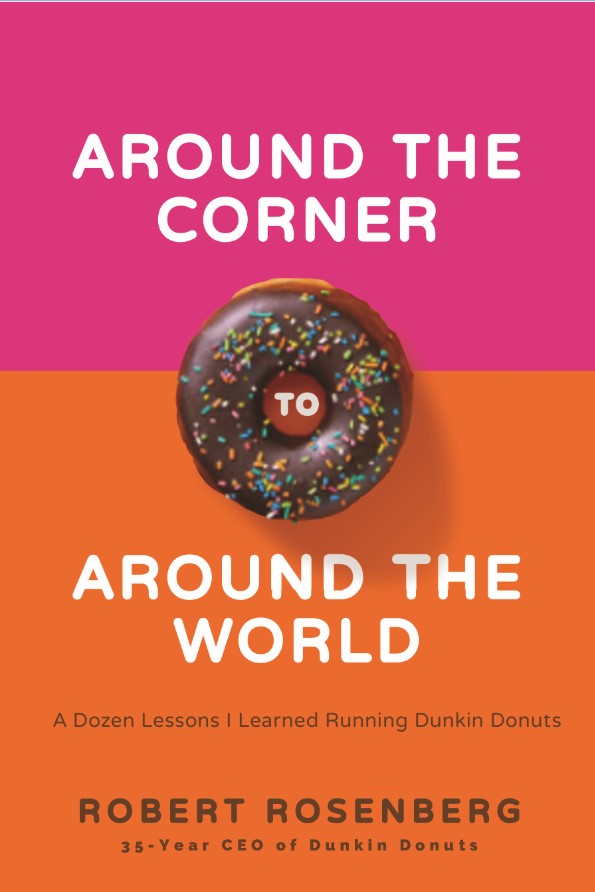To receive these weekly articles, subscribe here.
This blog is a modified version of the Introduction to Robert Rosenberg’s new book Around The Corner To Around The World. Robert served as the CEO of Dunkin’ Donuts for 35 years. It is a companion to his interview on Innovating Leadership, Co-creating Our Future titled A Dozen Lessons Learned Running Dunkin’ Donuts that aired on Tuesday, March 16th, 2021.
 Every morning, five million people around the world start their day with a cup of Dunkin’ Donuts coffee. Thirsty customers in search of their favorite pick-me-up can find their fix in more than eleven thousand stores and in more than forty countries. In the United States, the brand enjoys a 95 percent recognition rate among consumers. In head-to-head taste comparisons between Dunkin’s original brew and Starbucks blend, Dunkin’ was preferred 58 percent to 42 percent.1 In part due to these achievements, Wall Street has placed a market value of nearly $6.5 billion on the enterprise known as Dunkin’ Brands.2
Every morning, five million people around the world start their day with a cup of Dunkin’ Donuts coffee. Thirsty customers in search of their favorite pick-me-up can find their fix in more than eleven thousand stores and in more than forty countries. In the United States, the brand enjoys a 95 percent recognition rate among consumers. In head-to-head taste comparisons between Dunkin’s original brew and Starbucks blend, Dunkin’ was preferred 58 percent to 42 percent.1 In part due to these achievements, Wall Street has placed a market value of nearly $6.5 billion on the enterprise known as Dunkin’ Brands.2
This was not always the case. From humble beginnings—a single shop in Quincy, Massachusetts, in 1950—Dunkin’ Donuts grew over the years into one of the world’s most beloved brands through sheer perseverance and grit, talent, and a little bit of luck. This memoir chronicles the trials and tribulations, the dizzying highs when we got it right and the heart-thumping near-death lows of when I got it wrong.
This is a story of a family business transforming from a small, regional diversified food service company into the worldwide, iconic brand it is today. More than anything else, it is a story of change. Sometimes it was a pivotal switch-up in management that affected all levels of the business, or merely a refinement in the menu that sent sales skyrocketing. Deceptively simple adjustments in the service delivery system transformed our retail concept in fundamental ways. A more sophisticated location and marketing strategy increased sales dramatically, while a new purchasing system saved our franchisees tens of millions of dollars. The fact is that our team— both franchise owners and management together—continually adapted to an ever-changing consumer and competitive landscape. This adaptability enabled us to build this world-renowned brand that I had the good fortune to shepherd for more than thirty-five years.
Since my time and exposure with this company parallels the mind-blowing growth of the fast-food business, as well as the franchise system of distribution, business readers are sure to find value in this tale as well.
Growing any business is not for the faint of heart; not in 1950 when Dunkin’ began, not during the years I was at the helm, 1963– 98, and certainly not today. So to all those entrepreneurs building their own businesses today or contemplating buying a franchise, I would hope our successes and failures would be a valuable springboard and provide important lessons and helpful insights—or cautionary tales—for your own ventures.
Thousands of executives, staff, and franchise owners past and present who have built this wonderful business. It was their adaptability, courage, and genius that made Dunkin’ Donuts a legendary and dominant global brand around the world.
In my experience, these are the four critical functions of an effective CEO.
- The first is strategy. Strategy is the controlling plan that sets out what an enterprise wishes to be, what it wishes to achieve, and the most important action steps it needs to take to marshal scarce resources in the achievement of its mission and objectives.
- The second lens is organization, which deals with the recruitment, retention, and motivation of the appropriate staff to achieve the strategy.
- The third is communication, the aim of which is to align all constituents enthusiastically behind the achievement of the strategy.
- The fourth and final category I call crisis management, where I parse the issues that posed either a threat or opportunity to the enterprise, requiring the attention of the CEO.
After due reflection on three-and-a-half decades at the helm of a dynamically growing business, six years teaching as an adjunct in the graduate program of a leading entrepreneurial college, and decades as a board member of several well-known food service companies, I’ve become convinced of the worth of this counsel.
Taken from Around the Corner to Around the World by Robert Rosenberg. Copyright © 2020 by Robert Rosenberg. Used by permission of HarperCollins Leadership. www.harpercollinsleadership.com
To become a more innovative leader, you can begin by taking our free leadership assessments and then enrolling in our online leadership development program.
Check out the companion interview and past episodes of Innovating Leadership, Co-creating Our Future, via iTunes, TuneIn, Stitcher, Spotify, Amazon Music and iHeartRADIO. Stay up-to-date on new shows airing by following the Innovative Leadership Institute LinkedIn.
About the Author
Robert Rosenberg served as chief executive officer of Dunkin Donuts from 1963 until his retirement in 1998. Under his leadership, the company grew from a regional family business to one of America’s best-known and loved brands. Rosenberg received his MBA from Harvard Business School, and in just weeks after graduating at the age of 25, assumed the position of chief executive officer. After retiring from Dunkin, Rosenberg taught in the Graduate School at Babson College and served many years on the boards of directors of other leading foodservice companies, including Domino‘s Pizza and Sonic Restaurants





